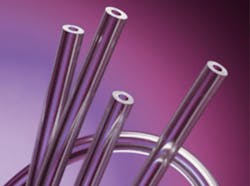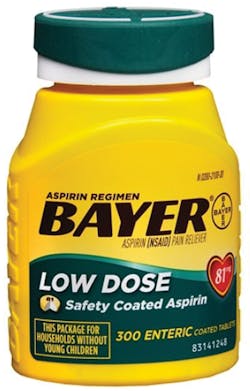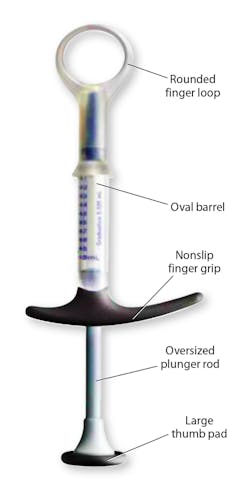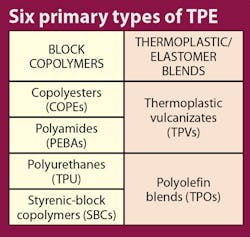|
By Larry Johnson, Malar Shetty, PolyOne Corp., Avon, Ohio |
Thermoplastic elastomers (TPEs) play a big role in the design of ergonomically enhanced products. TPE sales grow at about 4 to 6% annually in the health-care market alone.
Health-care products need more of these plastics because of a graying population. The population is aging worldwide, not just in the U.S. By 2050, the number of people aged over 60 in emerging countries, for example, is expected to nearly triple.
One of the biggest problems that graying populations face is arthritis. Arthritis is the breakdown and inflammation of cartilage in joints. While there are over 100 types of arthritis, they all have negative consequences ranging from pain and limited function of joints including joint stiffness, swelling, redness, and warmth. Arthritis hinders muscle effort needed for simple tasks like screwing off a lid or operating scissors. Designers are using TPE to redesign health-care products to help assist the growing epidemic of arthritis sufferers.
Taking the headache out of packaging
Each TPE-covered cap is color coded to match the graphics of each SKU, making it easier to identify the various strengths of aspirin.One example of the role TPE can play comes from Bayer Consumer Care, a division of Bayer HealthCare in Morristown, N.J., which in 2009 introduced new packaging for a line of aspirins. Its main objective was to create an easy-open bottle for arthritis sufferers.
Patient-operated tools
Most syringes are designed to accommodate the expert practitioner rather than the patient who receives the contents. But with a graying population, more patients are being treated at home and controlling their own injections.
Other alterations were made to help those with poor eyesight. The barrel is magnified to make dosages easier to read and help patients see when they’ve injected the entire dose. The barrel is also made in the shape of an ellipse to make it less likely to slip. The syringe comes with instructions accompanied by clear visuals for those who can’t see small print. The packaging is a plastic housing with large finger wells and includes hook-and-loop repositionable tabs for easy opening.
What are TPEs
Until 1996, the six primary TPE types could be categorized into two generic classes, block copolymers or thermoplastic/ elastomer blends and alloys.
TPEs have been used for decades in the medical industry for applications ranging from medical bags and tubing to surgical instruments. They are used for disposable, as well as reusable products. This is true of most TPE classes, but especially for styrenic- block copolymers (SBCs) and thermoplastic vulcanizates (TPVs). These two segments have the properties that make for a soft feel, a nonslip grip, and a velvety aesthetic finish that complements the device to which they are being fastened. They are also both moderately inexpensive compared to the other segments.
These segments can be formulated to pass medical regulatory testing such as USP Class VI, ISO 10993, and FDA. They can be modified to be sterilized via gamma and ethylene oxide (EtO) techniques. In addition, SBC TPEs have clarity, which denotes cleanliness and allows practitioners to see within and sometimes through the border of the part. They are also inert and nonallergenic, which make them usually safe for skin contact.
TPEs contain no phthalate-based plasticizers, which make them excellent candidates for vinyl replacement. They can also bond to a variety of substrates and are solvent bondable.
Unlike conventional vulcanized rubbers, TPEs can be processed by melting repeatedly and also recycled like thermoplastic materials. They are known as two-phase systems. Essentially, a hard thermoplastic phase is coupled mechanically or chemically with a soft elastomer phase, resulting in a TPE that has the combined properties of the two phases.
They are similar to thermosets because they can resume their original shape when stretched or deformed at room temperature. TPEs in their basic form are used for injectionmolded, extruded, and blow-molded products. They can also be used to modify the properties of rigid thermoplastics, usually improving impact strength. This is a common practice for sheet goods and general molding compounds.
Hardness is one of the key qualities of TPE materials. The relative softness or hardness of a material is often one of the first criteria considered when picking a TPE. Hardness is also related to other important design properties, such as tensile and flexural modulus. Confusion can arise when discussing hardness due to the variety of measurement scales and its relationship to other material properties. The most common measure of hardness is the Shore Scale of hardness with most TPEs measuring along the Shore A or Shore D scale.
How to incorporate TPEs
TPEs can be processed using thermoplastic processes with lower cycle times than thermoset rubbers. This makes them an alternative to thermoset rubbers such as silicone and butyl rubber. They can serve in numerous medical applications such as stoppers, gaskets, and tubing. They can also replace flexible plastics such as PVC because they can be processed using the same equipment.
Soft touch applications generally involve overmolding TPEs onto a rigid substrate. Two-shot and insert injectionmolding techniques are the technologies employed. The result is a soft outer layer of TPE material over a rigid substrate giving a soft-touch feel along with the stiffness and strength of a supporting structure.
TPE is used in health care because it is low cost, can be clear or can match colors, and offers tactile feel for gripping.SBC and TPV-type TPE materials have a natural chemical affinity to olefin-based rigid polymers such as polypropylene (PP) and polyethylene (PE). They are often overmolded or extruded onto these materials because of that affinity. But olefinic materials are not always good material choices, especially for applications needing structural properties over and above what olefinic materials can deliver.
Other engineered materials such as nylons, polycarbonates, ABS, and PC/ABS alloys are sometimes better choices for applications that need mechanical and physical properties, which olefins can’t provide. New bondable TPE formulations have been developed to stick to these more highly engineered materials. This development gives engineers more flexibility in developing ergonomic applications with soft-touch parts. But if inherent bondability is not an option, TPEs can be mechanically adhered to nearly any substrate whether polymeric, metallic, or ceramic.
|
Causes of physical ergonomic issues Repetitive motions that happen for prolonged periods cause fatigue and muscle strain, especially if there is not sufcient resting periods. Contact stresses are repeated and continuous contact with a hard or sharp object that may create pressure on one area of the body. Vibration can arise when the whole body or part of the body touches a vibrating object such as a hand tool. |
Resources:
Arthritis Bayer’s Bottles Go Cartonless
Ergonomic Principles in the Design of Healthcare Environments
Introduction to Ergonomics
User Interface
Oxo Redesigns the Common Syringe
PolyOne Corp.
For a video on TPEs, scan this code or go to: http://tinyurl.com/by5ohfu
Edited by Lindsey Frick
[email protected], @MaterialShout





